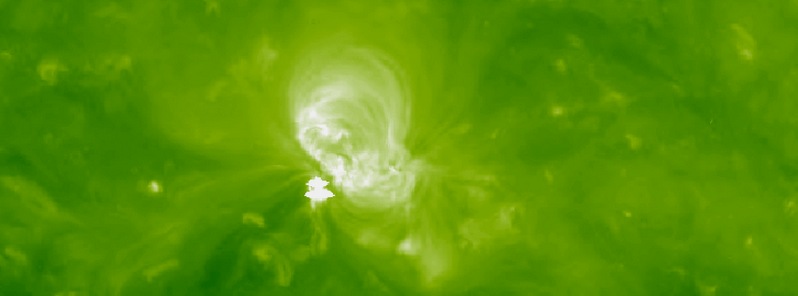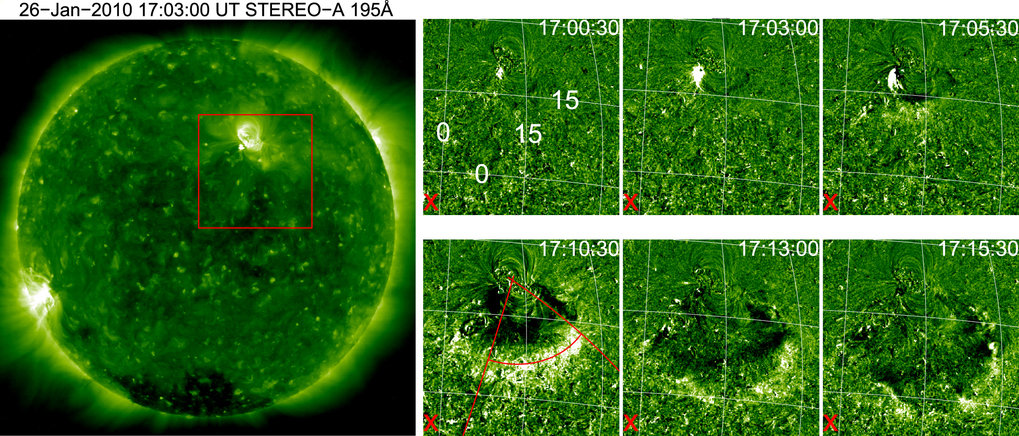New solar phenomenon discovered: large-scale waves accompanied by particles emissions rich in helium-3

Joint US and German research teams have discovered a new form of solar ejection involving high energy blast waves and helium-3 based particle matter. The discovery was aided by NASA spacecraft STEREO A and ACE.
A new solar phenomenon has been discovered by two research teams led by Nariaki Nitta from the Lockheed Martin Advanced Technology Center in the USA and Radoslav Bucík from the Max Planck Institute for Solar System Research (MPS) in Germany. They have discovered that large-scale waves in the Sun's atmosphere are accompanied by energetic particle emissions rich in helium-3 (a light form of the inert gas helium).
Moreover, these waves may play a significant part in accelerating these helium-3 particles into space. Two NASA spacecraft, STEREO A and ACE, played a major role in this discovery by viewing the Sun from two different directions at once. This research was featured in The Astrophysical Journal on October 7, 2015.
The Sun's surface is highly active. The average solar eruption is accompanied by other solar phenomena like Coronal Mass Ejections (CMEs) where a plasma of electrons, protons, and a few heavy atoms is hurled into space, as well as short, collimated solar flares.

A look at the Sun’s right limb on January 26, 2010. Within the marked red square a large-scale blast wave travels through the Sun’s atmosphere. These images were obtained with the help of NASA’s STEREO A probe and show the Sun’s atmosphere in extreme ultraviolet light. Image credit : NASA/STEREO A/MPS/AAS
The high energy waves were detected in data collected between January 26, 2010 and February 2, 2010. The waves encompassed over half a million kilometers (0.31 million miles) in area and accelerated at a speed of approximately 300 kilometers per second (186.4 miles per second). Unlike other solar phenomena, Coronal Mass Ejections (CMEs) did not act as a trigger for the newly discovered waves. The waves were preceded by a weak solar X-ray flare. However, the blast waves have nothing in common with this typical form of solar radiation. "The new phenomenon is like a kind of explosion," said Bucik, who headed the team of researchers at the MPS, the Johns Hopkins University, and the Jet Propulsion Laboratory in the US.
The researchers also found that a Helium-3 rich particle stream is emitted by the Sun simultaneously with the blast waves. Such particle emissions aren't rare and are well known. However, researchers have been unable to explain this phenomena so far.
“We believe that the blast waves accelerate the Helium-3,” says Davina Innes from the MPS. "Our analysis shows that typical characteristics of the waves, such as their energy, influence the properties of the particles”, adds her colleague Lijia Guo, also stationed at the MPS. However, how exactly this works, is still unclear.
The link between the blast waves and the Helium-3 emissions was confirmed by observing the Sun from two different directions at the same time. In 2010 when this data was collected, STEREO A was positioned exactly above the right limb of the Sun allowing it to record the solar region from where these blast waves and particle streams originated. Simultaneously, ACE, which was orbiting close to Earth could detect the Helium-3 rich particles. "STEREO A is the only solar observatory in space, which does not remain close to Earth, but travels around the Sun," explains Bucik.
The researchers believe that the newly discovered blast waves are pretty common but not easily viewable. "Unfortunately, however, in the foreseeable future the necessary viewing geometry will not occur again,” says Bucik.
References:
- "Observations of EUV Waves in 3He-rich Solar Energetic Particle Events" – R. Bucík, D. E. Innes, L. Guo, G. M. Mason and M. E. Wiedenbeck – The Astrophysical Journal, Volume 812, Number 1, 7 October 2015 – doi:10.1088/0004-637X/812/1/
53 - "Blast waves in the Sun’s atmosphere" – article published by Max Planck Institute for Solar System Research (MPS) in Germany
Featured image credit: NASA / STEREO-A SECCHI EUVI 195 taken on January 26, 2010 at 17:03 UTC

Commenting rules and guidelines
We value the thoughts and opinions of our readers and welcome healthy discussions on our website. In order to maintain a respectful and positive community, we ask that all commenters follow these rules.